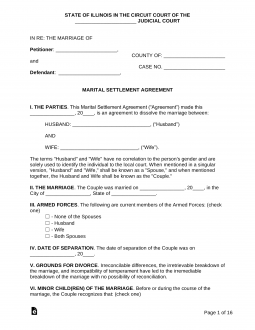Updated April 16, 2024
An Illinois marital settlement agreement is a contract that lays out how a married couple intends to manage their child care responsibilities and divide marital property after a divorce. During the legal proceedings for divorce, or “Dissolution of Marriage,” a judge will review the case and make decisions for the couple concerning property rights, child custody, spousal support (alimony), and other related matters. By drafting a marriage settlement agreement, the couple eliminates the judge’s capacity to make such decisions and, instead, allows them to control the outcome of their property, children, and finances. The conditions stated in the agreement become legally binding after the judge issues a divorce judgment.
Table of Contents |
Divorce Laws
Statutes – 750 ILCS 5 (Illinois Marriage and Dissolution of Marriage Act)
Alimony (750 ILCS 5/504) – The court considers the following factors when awarding alimony:
- The income and property of each spouse;
- The needs of each spouse;
- The realistic earning capacity of each spouse, both in the present and in the future;
- The present and future impairment of the earning capacity of the spouse seeking alimony due to their domestic duties or because they sacrificed or delayed their education, employment, training, or career opportunities as a result of the marriage;
- The time needed for the spouse seeking alimony to acquire education, training, or employment, and whether said employment will sustain the spouse financially;
- How the parental responsibilities of each spouse have affected their ability to acquire and sustain employment;
- The living standards established while married;
- How long the marriage has lasted;
- The age and health of each spouse;
- Each spouse’s occupation, skills, estate liabilities, and other income sources (e.g., disability, retirement);
- Tax consequences;
- The contributions a spouse made to the other’s education and career; and
- A marriage settlement agreement and any other factors the court deems fair.
Alimony Calculator – calculators.law
Child Support (750 ILCS 5/505) – These guidelines determine a spouse’s child support obligations.
Child Support Calculator – cscwebext.hfs.illinois.gov
Division of Property (750 ILCS 5/503) – Illinois uses equitable distribution to divide marital property. This means that the court will divide property as they deem just and fair, not necessarily equally.
Grounds for Divorce (750 ILCS 5/401) – The court must find that the marriage has deteriorated due to “irreconcilable differences” between the couple and that all previous attempts at reconciliation have failed or that future attempts at reconciliation would be futile and not in the couple’s best interests. Furthermore, 750 ILCS 5/401(a-5) states that if the couple lives separately for six (6) months preceding the divorce case, the court will presume that grounds for divorce have been met.
Interim Support (750 ILCS 5/501) – Either party in a divorce case can request temporary relief in the form of maintenance (alimony) and child support. After the couple has successfully divorced, the temporary relief will be revoked.
Residency (750 ILCS 5/401(a)) – One (1) of the spouses must maintain residency in Illinois for ninety (90) days before filing for divorce.
Divorce Forms
- Where to File – Circuit Court
- Filing Fee – Depends on the county
- How Long Does it Take? Around ninety (90) days (source: 3stepdivorce.com)
Before filling out the divorce forms, the filer should first review the instructional guides below to ensure the documents are completed properly.
- Instructions for Uncontested Divorce with No Children
- Instructions for Uncontested Divorce With Children
Uncontested Divorce with No Children:
- Petition for Dissolution of Marriage/Civil Union (DV-P 103.2)
- Summons (DV-SU 113.4)
- Entry of Appearance (DV-A 111.3)
- Judgment of Dissolution of Marriage/Civil Union (DV-J 104.2)
- Non-Marital Real Estate (DV-RE 112.2)
- Additional Debts & Liabilities (DV-AD 109.3)
- Additional Personal Property & Bank Accounts (DV-AP 110.3)
- Letter to the Sheriff (DV-LS 115.1)
- Answer/Response to Complaint/Petition (AR-A 1403.3)
- Additional Paragraphs for Answer/Response to Complaint/Petition (AR-AP 1404.2)
- Certificate of Dissolution of Marriage*
Uncontested Divorce With Children:
- Petition for Dissolution of Marriage/Civil Union (DV-P 105.1)
- Summons (DV-SU 113.4)
- Entry of Appearance (DV-A 111.3)
- Judgment of Dissolution of Marriage/Civil Union (DV-J 106.1)
- Non-Marital Real Estate (DV-RE 112.2)
- Parenting Plan (DV-PP 108.1)
- Additional Personal Property & Bank Accounts (DV-AP 110.3)
- Additional Debts & Liabilities (DV-AD 109.3)
- Additional Minor Children (DV-AM 123.2)
- Additional Adult Children (DV-AA 124.1)
- Additional Other Children (DV-AO 125.2)
- Additional Parenting Time (DV-APT 134.2)
- Letter to the Sheriff (DV-LS 115.1)
- Certification Agreement (DV-CA 122.1)
- Answer/Response to Complaint/Petition (AR-A 1403.3)
- Additional Paragraphs for Answer/Response to Complaint/Petition (AR-AP 1404.2)
- Order for Support (DV-CSO 129.1)
- Certificate of Dissolution of Marriage*
*This form is used when a spouse wishes to revert to their former name after divorce. If this document is required, the filer can obtain it from a clerk of the circuit court.
How to File for Divorce in Illinois (8 steps)
- File Petition for Divorce
- Parental Responsibilities and Child Support
- Additional Paperwork
- Serve Notice to Other Spouse
- Answering the Petition
- Prepare for Court Hearing
- Court Date
- Name Change
1. File Petition for Divorce

To start the filing process, one (1) spouse will need to fill out a Petition for Dissolution of Marriage/Civil Union (without children) or Petition for Dissolution of Marriage/Civil Union (with children) with the circuit court in their county. The petition can be filed in person or electronically using one of the court-approved e-filing service providers. A filing fee will be charged upon submission, the amount of which will vary depending on the court. If the filer cannot afford the fee, they can ask the court to reduce the filing costs or waive the fee altogether (see fee waiver instructions).
2. Parental Responsibilities and Child Support
If the spouses are the parents of a minor child, they will need to attend an educational program to develop parenting skills and prepare them for issues commonly experienced by children during a divorce case. The parents should contact a clerk of the circuit court for information about attending this program. Additionally, the court may ask the parents to complete a Parenting Plan to establish their day-to-day parental responsibilities and decision-making rights.
3. Additional Paperwork

Supplementary forms may be required to further describe the couple’s assets, property, children, parental responsibilities, and debts. These documents are as follows:
- Non-Marital Real Estate (DV-RE 112.2)
- Additional Debts & Liabilities (DV-AD 109.3)
- Additional Personal Property & Bank Accounts (DV-AP 110.3)
- Additional Minor Children (DV-AM 123.2)
- Additional Adult Children (DV-AA 124.1)
- Additional Other Children (DV-AO 125.2)
- Additional Parenting Time (DV-APT 134.2)
Any additional forms completed by the filer must be submitted to the court where the divorce case was filed.
4. Serve Notice to Other Spouse

The spouse filing for divorce will need to inform the other spouse that the divorce case has been filed. There are two (2) ways to provide notice in Illinois:
- Entry of Appearance
- Personally notify the other spouse and ask them to file an Entry of Appearance with the court. This document tells the court that the spouse has been notified and that they are prepared to proceed with the divorce case.
- Summons
- The filer must provide two (2) copies of both the Summons and divorce petition to the sheriff’s office in the county where the other spouse lives. The filer must then submit a Letter to the Sheriff to formally request service of the documents. After the filer pays a small fee, the sheriff will serve the other spouse with the divorce documents. Following service, the sheriff will complete the Return of Service section of the Summons and then file it with the circuit court or mail it back to the filer. If returned to the filer, they must make a copy and file the original Summons with the circuit court.
5. Answering the Petition
After the other spouse has been notified of the pending divorce case, they will have thirty (30) days to file an Answer/Response to Complaint/Petition. This form allows the other spouse to state whether they agree with or deny the claims made in the divorce petition. Should additional space be required in the answer form, the other spouse may use the Additional Paragraphs for Answer/Response to Complaint/Petition. Once complete, the documents must be filed with the circuit court, and copies must be delivered to the spouse who filed for divorce. A hearing date will be scheduled after the court receives the answer form.
6. Prepare for Court Hearing
Next, the parties will need to outline the terms of their divorce in a Marital Settlement Agreement. This legally binding contract explains how the couple’s assets will be divided and how child care responsibilities will be handled once the marriage ends. The couple must also prepare a Judgment of Dissolution of Marriage (with children) or Judgment of Dissolution of Marriage/Civil Union (without children). If a spouse intends to request child support, the spouse seeking support must also bring an Order for Support to the court hearing. Lastly, parents will need to sign a Certification Agreement in front of a notary public to indicate their compliance with the documents that will be presented to the judge.
7. Court Date
The parties must appear in court on the date scheduled by the circuit clerk. They must bring copies of all documents used thus far and any original forms not yet filed. A judge will review the case details and the terms set forth in the settlement agreement. If the judge determines that the settlement agreement is fair, they will sign the Judgment to approve the divorce, thus ending the marriage. The parties should request copies of the Judgement along with the Parenting Plan and Order for Support (if applicable).
8. Change Name
If a spouse was granted permission to revert to their former name after divorce, they must ask a circuit clerk to issue a Certificate of Dissolution of Marriage (there will likely be a fee for this). The spouse can use the certificate as proof of the name change when updating their personal details with the Secretary of State and Social Security Administration.


